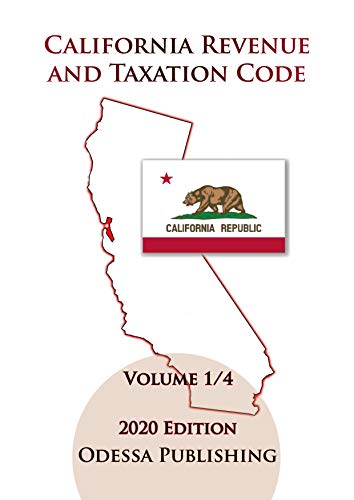
California Revenue and Taxation Code. (Photo: www.ca.gov)
Drafting Tax Statutes in California
Despite California’s recent rule of gender-neutral bill drafting, Section Twelve provides that the masculine gender includes the feminine and neuter
By Chris Micheli, October 21, 2021 6:48 am
Like other particular areas of the law, drafting tax statutes can be a difficult task for any bill drafter. There are several issues that need to be addressed and that bill drafters should understand before undertaking the drafting of tax legislation.
General Provisions of the Code
California laws are separated into 29 Codes. One of these codes is the California Revenue and Taxation Code (often referred to as “CRTC”). At the beginning of the CRTC, like in many other Codes, there are general provisions. Section One of the CRTC is obvious in that it states “This act shall be known as the Revenue and Taxation Code.”
Section Two of the CRTC specifies that the provisions of this Code in so far as they are substantially the same as existing statutory provisions relating to the same subject matter shall be construed as restatements and continuations, and not as new enactments.
Section Nine of the CRTC provides that, whenever any reference is made to any portion of this code or of any other law, the reference applies to all amendments and additions thereto now or hereafter made. Section Ten of the CRTC establishes that “section” means a section of this code unless some other statute is specifically mentioned and “subdivision” means a subdivision of the section in which that term occurs unless some other section is expressly mentioned.
Thereafter, several general provisions are set forth, such as Section Eleven that the present tense includes the past and future tenses; and the future, the present. Despite California’s recent rule of gender-neutral bill drafting, Section Twelve provides that the masculine gender includes the feminine and neuter. Section Thirteen specifies that the singular number includes the plural, and the plural the singular. And, Section Sixteen provides that the word “shall” is mandatory and “may” is permissive.
Then the CRTC provides some general provisions unique to this Code. For example, Section Nineteen states that “person” includes any person, firm, partnership, general partner of a partnership, limited liability company, registered limited liability partnership, foreign limited liability partnership, association, corporation, company, syndicate, estate, trust, business trust, or organization of any kind. In addition, as used in Division 2 (commencing with Section 6001), “person” shall include, in addition to the items of definition contained in the first sentence, trustee, trustee in bankruptcy, receiver, executor, administrator, or assignee.
Also, with the removal of all statutory powers from the State Board of Equalization and giving those powers to the California Department of Tax and Fee Administration, Section Twenty specifies that, except as otherwise provided, and notwithstanding any other law, “board” means the California Department of Tax and Fee Administration.
The CRTC also provides several definitions for terms that are used throughout this Code, such as Section Twenty-One that states “Controller” means the State Controller. Section Twenty-Two defines “auditor” of a city or county means the chief accounting officer, by whatever title he may be known. Section Twenty-Three specifies “assessee” means the person to whom property or a tax is assessed. Section Twenty-Eight Point Five states that, “As used in Division 1 of this code, “partnership” shall include limited liability company, registered limited liability partnership, and foreign limited liability partnership, except where the context or the specific provisions of this division otherwise require.”
The CRTC also provides several unique general provisions, such as Section Twenty-Four that specifies: “No act in all the proceedings for raising revenue by taxation is illegal on account of informality or because not completed within the required time.” Section Twenty-Five of the CRTC provides, “Unless expressly otherwise provided, any notice required to be given to any person by any provision of this code may be given in the manner prescribed in the Code of Civil Procedure for service by mail.”
Section Thirty of the CRTC specifies that the courts of this State shall recognize and enforce liabilities for taxes lawfully imposed by any other state, or the political subdivisions thereof, which extends a like comity to this State. And, Section Thirty-One provides that the Attorney General or an appropriate official of any political subdivision of this State may bring suits in the courts of other states to collect taxes legally due this State or any political subdivision thereof. The officials of other states which extend a like comity to this State are empowered to sue for the collection of such taxes in the courts of this State. A certificate by the Secretary of State under the Great Seal of the State that such officers have authority to collect the tax is conclusive evidence of such authority.
Pursuant to Section Thirty-Six Point Five, whenever the CRTC requires the tax collector to publish a notice in a newspaper, the tax collector shall also provide notice on the tax collector’s regularly maintained Internet Web site.
Tax Levies
Under Article IV, Section 8(c)(3) of the California Constitution, “statutes calling elections, statutes providing for tax levies or appropriations for the usual current expenses of the State, and urgency statutes shall go into effect immediately upon their enactment.” This begs the question of what is a “tax levy”? Unfortunately, it is not defined in either the state Constitution or in statute.
A common misconception is that a “tax levy” is a tax increase bill. However, that is not the case. While a tax levy is usually a collection tool used by the government, for California bills, a “tax levy” is any bill that imposes, repeals, or materially alters a state tax.
The Legislative Counsel indicates in the Title and Digest of the bill whether the bill is a tax levy. Specifically, the Digest will contain the following statement, generally at the end of the Digest: “This bill would take effect immediately as a tax levy.”
A bill reader will likely see the following language in the text of a California bill:
This act provides for a tax levy within the meaning of Article IV of the California Constitution and shall go into immediate effect.
Retroactive Tax Law Change
Existing state constitutional law (Section 6 of Article XVI on Public Finance) prohibits the Legislature from making any gift, or authorizing the making of any gift, of any public money or thing of value to any individual, municipal, or other corporation. This constitutional provision comes into play when the Legislature determines that a retroactive tax law change should be made.
The courts in this state have determined that a retroactive tax law change that results in tax savings (e.g., a tax credit, exemption, deduction, etc.) constitutes a gift of public funds. However, the state courts have also ruled that the Legislature may make such a determination so long as the bill contains a finding that such a retroactive tax law change is warranted.
Specifically, the bill must contain certain legislative findings and declarations that its provisions serve a public purpose. An example of language found in a California bill during the 2021 Session is the following:
The Legislature hereby finds and declares that the deductions and other tax benefits authorized by the amendments to Sections 17131.8 and 24308.6 of the Revenue and Taxation Code made by this bill serve the public purpose of providing California businesses relief from taxation on expenses made with Paycheck Protection Program loans and do not constitute a gift of public funds within the meaning of Section 6 of Article XVI of the California Constitution.
Complying with Section 41
CRTC Section 41 was added to the code to require any new “tax expenditure program,” basically a tax benefit such as a credit, exemption, exclusion, or deduction. Section 41 is set forth below:
(a) Notwithstanding any other law, any bill, introduced on or after January 1, 2020, that would authorize a new tax expenditure under Part 10 (commencing with Section 17001) of Division 2, Part 11 (commencing with Section 23001) of Division 2, or both, or that would authorize an exemption from the taxes imposed by Part 1 (commencing with Section 6001) of Division 2, shall contain all of the following:
(1) Specific goals, purposes, and objectives that the tax expenditure will achieve.
(2) Detailed performance indicators for the Legislature to use when measuring whether the tax expenditure meets the goals, purposes, and objectives stated in the bill.
(3) Data collection requirements to enable the Legislature to determine whether the tax expenditure is meeting, failing to meet, or exceeding those specific goals, purposes, and objectives. The requirements shall include the specific data and baseline measurements to be collected and remitted in each year the tax expenditure is in effect, in order for the Legislature to measure the change in performance indicators, and the specific taxpayers, state agencies, or other entities required to collect and remit data.
(b) For purposes of this section, “tax expenditure” means a credit, deduction, exclusion, exemption, or any other tax benefit as provided for by the state.
(c) Taxpayer information collected pursuant to this section is subject to Sections 7056.5 and 19542.
In reading a California bill, the Legislative Counsel’s Digest will provide language along these lines, which was taken from a bill during the 2021 Session:
Existing law requires any bill authorizing a new tax expenditure, defined to include an exclusion from income, to contain, among other things, specific goals, purposes, and objectives that the tax expenditure will achieve, detailed performance indicators, and data collection requirements.
This bill would state the intent of the Legislature to comply with the additional information requirements of any bill authorizing a new tax expenditure.
This bill would take effect immediately as a tax levy.
In addition, in the text of the bill, there will either be a general intent statement about complying with Section 41, or specific findings. The following is a general statement that may be found in a California bill:
It is the intent of the Legislature to comply with Section 41 of the Revenue and Taxation Code.
On the other hand, the following is a detailed findings statements were contained in a California bill during the 2021 Session:
(b) (1) For the purposes of complying with Section 41, the Legislature finds and declares that the goals, purposes, and objectives of this exclusion are both of the following:
- To recognize the loss and sacrifice of our military families and give them the support that our community owes.
(B) To provide some financial relief to families that have experienced not only the loss of a loved one, but also often the loss of the sole income of the family, and who are now trying to make ends meet on a portion of that original income.
There are undoubtedly other drafting reminders for those working on tax bills that will add, amend or repeal sections of the California Revenue and Taxation Code. But the ones specified above provide key points to remember when drafting bills in this area of California law.
- Frequently Asked Questions about When Elected Officials Take Office - April 25, 2024
- Frequently Asked Questions About Ethics Training for Local Agencies - April 24, 2024
- Frequently Asked Questions about Privileges of Voters in California - April 23, 2024




